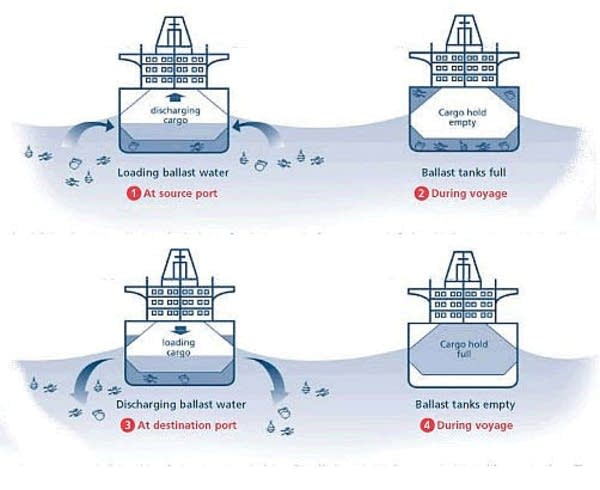New ballast rules could take toll on Wis. shipping

Ocean-going ships make up about 10 percent of the arrivals in the Duluth Superior harbor. Many of those ships are loaded with grain in Superior, but Superior officials fear they could lose that business under Wisconsin's new rules for ship ballast water.
The Wisconsin Department of Natural Resources is proposing rules governing the number of organisms found in ship ballast water that's 100 times more restrictive than Minnesota's. For newly-built ships, regulations would be 1,000 times tougher.

But unlike Minnesota's, which govern both ocean-going ships and the interlake lakers, Wisconsin regulations primarily target ocean vessels - the salties.
Wisconsin DNR Secretary Matt Frank said while the interlake ships might move invasives around, it's the salties that bring them into the lakes from overseas.
Create a More Connected Minnesota
MPR News is your trusted resource for the news you need. With your support, MPR News brings accessible, courageous journalism and authentic conversation to everyone - free of paywalls and barriers. Your gift makes a difference.
"We really need to get to the root of the problem, which is continued introduction of new invasives into the Great Lakes from ocean going vessels," Frank said.
This is Wisconsin's second go around on ballast. Regulations proposed last fall were opposed by environmental advocates as too weak. These much stronger rules are better, according to National Wildlife Federation State Policy Director Marc Smith.
"We like that it's very tough on seafaring ships, or salties," Smith said. "We like the fact that the time frames laid out are adequate and aggressive. And we also like the fact that they're requiring lakers to adhere to the best available treatment technologies that are out there."
But not so quick, according to Jason Serck, Port Director for the City of Superior.

"It will prevent salties from visiting the Port of Superior," Serck said.
Superior moves a lot of grain overseas through its waterfront elevators. In the Twin Ports, Serck said, ships have a choice.
"We have a lot of grain terminals over here," he said. "We do a majority of the grain shipping in the Duluth-Superior port, so, conceivably they could actually go over to the other docks over in Duluth if they cannot meet the requirements that are being set forth in the permit language that Wisconsin is putting forth right now."
Or, worse for the area, ships could load grain in Thunder Bay, Ontario.
And no one is happy with the patchwork permit system falling into place, one state at a time. Steve Sydow has to deal with the permits. He books visits to Duluth-Superior by salt water ships.
"First thing it's going to cause is mass confusion here," Sydow said. "We don't know what rules we're following and when."
A single ship could sail through two countries and eight different states - all with different requirements.
That's a bureaucratic mess that doesn't please anyone, according to Glen Nekvasil with the Lake Carriers Association, representing the interlake ship owners.
"Well that is precisely the nightmare that we have been predicting," Nekvasil said. "So now we have one standard in Minnesota. We have another in Michigan, another in Wisconsin, another in New York. And as a vessel operator, how do you try to comply with all these differing and possibly sometimes conflicting regulations?"
The best hope for ship owners would be the Federal Government stepping up with a single set of rules for all the states. A federal permit the EPA adopted last fall allows states like Wisconsin to impose much tougher requirements on top.
New EPA Director Lisa Jackson lit up the industry when she said two weeks ago something could be in the works.
"I don't have an answer for you today, but I wanted you to know that is very much on my radar screen," Jackson said.
That statement raised hope in the shipping industry that the patchwork would be smoothed out, but there's been no specific proposal that a change is coming on the federal level.
Short of new federal rules, Wisconsin intends to have the tough new standards in effect by 2012, leaving plenty of time for more fighting.
